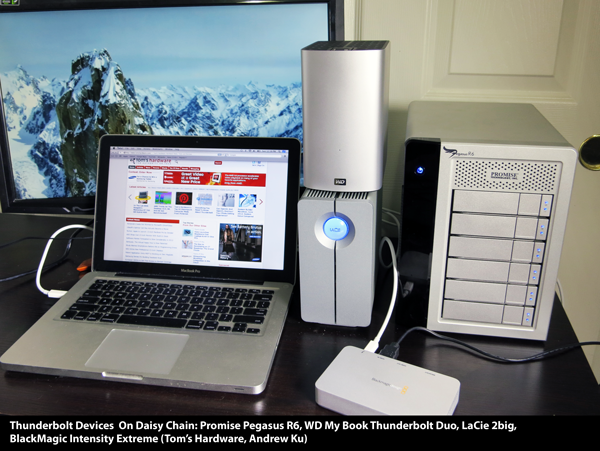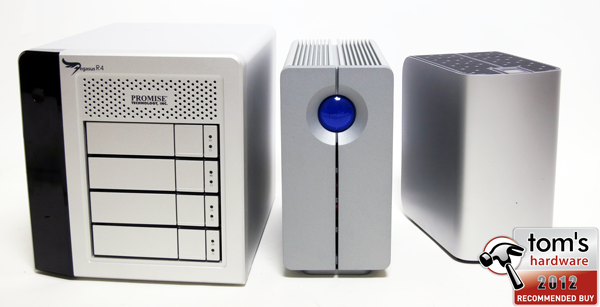Nine External Thunderbolt Storage Devices, Rounded Up
Thunderbolt: Faster Than USB 3.0; Three Winners Emerge
We know that Thunderbolt's maximum sequential throughput is close to the 1 GB/s mark, and Promise's Pegasus R6 has the unique distinction of saturating this new interface using six 3.5" hard drives. But it'd be wrong to assume that it takes $2000 to get the most out of Thunderbolt. Unlike USB, Thunderbolt was designed so that multiple devices can operate in parallel and still achieve their peak performance. You can get that same 1 GB/s from three or four peripherals doing 250 to 300 MB/s each.
This critically important advantage doesn't get enough attention. With USB, the interface bottlenecks performance, not the devices themselves. As an example, if you burn a DVD on a USB 2.0-based writer and write to a thumb drive, those conflicting operations could yield a useless coaster. Although USB 3.0 facilitates a lot more headroom, the technology is similar, and bottlenecks remain probable.
Thunderbolt alleviates interface limitations. Yeah, one LaCie 2big can "only" hit 350 MB/s in sequential reads. But a second 2big in the same chain can hit 350 MB/s, too. You can use those two drives, plus something like BlackMagic’s Intensity Extreme (a Thunderbolt-based external capture device used by professionals to edit 1080p content) and not have any of those three devices stepping on each others' toes. If that matters to your application, then spending money on high-end hardware probably isn't your top concern.
For everyone else, though, Thunderbolt does still face a big pricing problem. Even one 4 TB 2big at almost $600 reflects heavy mark-up. If you have room for a quartet of 1 TB disks inside your case, they'd only run about $360.
Those fat premiums will hopefully slim down over time. But even at a more attractive price, several of the devices in our round-up are haunted by other issues that call into question their utility. Elgato’s Thunderbolt SSD, for example, suffers from poor throughput because it employs an SSD based on SandForce's first-gen controller technology. That's fine for moving personal data around. But it's far less adept at handling encoded media files. Surely, a $420 price tag for 120 GB of capacity doesn't help. Seagate’s GoFlex Ultra-Portable Thunderbolt Adapter is only able to operate as an endpoint device. You can use it in a daisy chain, but you have to give up the potential for outputting to a display with a mini DisplayPort adapter.
Western Digital’s My Book Thunderbolt Duo competes directly with LaCie's 2big, but is hurt by slower drives. The thing is, the My Book Thunderbolt Duo costs $50 less than the 2big, which is a reasonable trade-off, so long as you're also able to accept the plastic case. They both offer notable value, earning LaCie's 2big 6 TB and Western Digital’s My Book Thunderbolt Duo 6 TB our 2012 Recommended Buy Award.
If you'd rather manage just a single Thunderbolt-based device (count us in), you can't ignore the incredible performance enabled by Promise's Pegasus R4 and R6. The SSD version of the R4 isn't final yet, but we're certainly impressed with our early preview.
Get Tom's Hardware's best news and in-depth reviews, straight to your inbox.
Performance and value are still vital criteria, though. The least-expensive Pegasus R4 costs 33% less than the R6, and sacrifices the same margin of sequential read performance. However, both units serve up identical sequential write speeds, making the R4 a better value. That also earns Promise's Pegasus R4 our 2012 Recommended Buy Award.
Current page: Thunderbolt: Faster Than USB 3.0; Three Winners Emerge
Prev Page Benchmark Results: Folder Transfer-
acku Reply9535164 said:No benchmark for 8-drive Thunderbolt deivces such as Areca ARC-8050 ?
What the R6 isn't expensive enough? :p Honestly, we couldn't include the ARC-8050 (http://www.areca.com.tw/products/thunderbolt.htm) because it's not readily available for purchase (yet).
Cheers,
Andrew Ku
TomsHardware.com -
mayankleoboy1 storage is OK, but an externally powered GPU is the most interesting application of thunderbolt.Reply
with the external PCI-E device specification coming soon, i believe the days of thunderbolt are limited. -
web2dot0 mayankleoboy1storage is OK, but an externally powered GPU is the most interesting application of thunderbolt.with the external PCI-E device specification coming soon, i believe the days of thunderbolt are limited.Reply
Thunderbolt IS ePCI-E. Well, using Intel's implementation. You think the specification will somehow make things cheaper? Nope. -
chovav Thank you Andrew for this review, it certainly makes it clear whether you should invest in thunderbolt or not.Reply
Could you maybe do add a random read/write graph comparing GoFlex Desk with USB3 and Thunderbolt?
I was also wondering what the CPU usage is during read/write - is there any impact at all? or does the thunderbolt controller bear all the processing grunt-work?
Thanks again, great article. -
CaedenV web2dot0Thunderbolt IS ePCI-E. Well, using Intel's implementation. You think the specification will somehow make things cheaper? Nope.thunderbolt is a medium that allows for multiple interconnect protocols to be transmitted over the same wire. It can send PCIe, it can send DP, it was supposed to be able to send USB 1/2/3, as well as Ethernet, all over the same wire... but we have not seen that happen over the copper version that was released.Reply
The external PCIe will be cheaper and easier because it will be hosted directly by the mobo chipset, or the CPU by tapping into already existing hardware. Chip makers will not have to add a new and expensive tech to the device, the connection will just siphon off lanes that are already there. And because it is already standardized and cheap technology it will be easier and cheaper to implement. Finally it will be an open standard that multiple manufacturers can adopt. Thunderbolt (as much as I love the idea) is made and operated by Intel, and Intel wants to charge a premium for it. Until there are multiple chip makers who can make it, then it will continue to be too expensive... and when multiple chip makers can make it then Intel will be the only one worth buying (much like their network interfaces) because nobody can do quality like intel, but at least the price will come down. -
mayankleoboy1 ^ like the Marvell SATA controllers.Reply
And thunderbolt is not going optical fibre in the coming years. the cable is too expensive and cant carry much power.
and the fact that apple is using it gives some clues about its price, compatibility, usability and openness.
i remember how TB was promoted : one single wire from your PC to a TB brick. and from that brick you added USB, ethernet, firewire, DP, HDMI. basically it was touted as "1 wire for everything". supposed to be magical, and we all know how that turns out.
-
acku CaedenVthunderbolt is a medium that allows for multiple interconnect protocols to be transmitted over the same wire. It can send PCIe, it can send DP, it was supposed to be able to send USB 1/2/3, as well as Ethernet, all over the same wire... but we have not seen that happen over the copper version that was released.The external PCIe will be cheaper and easier because it will be hosted directly by the mobo chipset, or the CPU by tapping into already existing hardware. Chip makers will not have to add a new and expensive tech to the device, the connection will just siphon off lanes that are already there. And because it is already standardized and cheap technology it will be easier and cheaper to implement. Finally it will be an open standard that multiple manufacturers can adopt. Thunderbolt (as much as I love the idea) is made and operated by Intel, and Intel wants to charge a premium for it. Until there are multiple chip makers who can make it, then it will continue to be too expensive... and when multiple chip makers can make it then Intel will be the only one worth buying (much like their network interfaces) because nobody can do quality like intel, but at least the price will come down.Reply
Read http://www.tomshardware.com/reviews/thunderbolt-performance-z77a-gd80,3205.html Thunderbolt can externalize anything. It just has to have the controller. It is external PCIe. External USB 3.0 and ethernet are possible but unlikely because they are already on the mobo.
From a practical standpoint, external PCIe may cheaper, but it's pointless from a performance standpoint http://en.wikipedia.org/wiki/PCI_Express#External_PCIe_cards. Everything is limited to a PCIe 1.0 x1 connection. The new ExpressCard standard (v2.0) ups bandwidth to slightly more than PCIe 1.0 x2, which still isn't that fast compared to TB (PCIe 2.0 x4 uplink). Plus ExpressCard only lets you connect a single device. It's one and done after that. For a mobile user, Thunderbolt is the way to go. Worse, you can't count on EC to be available. I'm already seeing Ultrabooks with TB. It makes sense because it doesn't require a lot of space. EC requires more space, hence it will be a greater rarity now that TB is out.
It looks expensive now but be patient. TB is something you will want. Many people need to look past the role Apple played. It clearly is a performance oriented technology that opens up a whole new world, especially on the mobile side.
Cheers,
Andrew Ku
Tom's Hardware.com
-
web2dot0 CaedenVthunderbolt is a medium that allows for multiple interconnect protocols to be transmitted over the same wire. It can send PCIe, it can send DP, it was supposed to be able to send USB 1/2/3, as well as Ethernet, all over the same wire... but we have not seen that happen over the copper version that was released.The external PCIe will be cheaper and easier because it will be hosted directly by the mobo chipset, or the CPU by tapping into already existing hardware. Chip makers will not have to add a new and expensive tech to the device, the connection will just siphon off lanes that are already there. And because it is already standardized and cheap technology it will be easier and cheaper to implement. Finally it will be an open standard that multiple manufacturers can adopt. Thunderbolt (as much as I love the idea) is made and operated by Intel, and Intel wants to charge a premium for it. Until there are multiple chip makers who can make it, then it will continue to be too expensive... and when multiple chip makers can make it then Intel will be the only one worth buying (much like their network interfaces) because nobody can do quality like intel, but at least the price will come down.Reply
Thank you for your Wikipedia quote. Everybody can quote from the spec sheet. The trouble is you make it seem like Intel are bunch of morons building a interconnect that nobody uses. That's is plain wrong. Just like SSDs, they will come down in price and next thing you know, you'll be asking yourself why in the world would I not use Thunderbolt. Imagine running a external GPU on your Retina Display MacbookPro when you dock your laptop. There'll be a lineup of people buying that technology at a premium price.
Partnering with Apple is no accident. 2 giant corporations backing the initiative is nothing to sneeze at. Give it a few years, and you'll soon find out the true power of Thunderbolt. USB 3.0 complements Thunderbolt.

